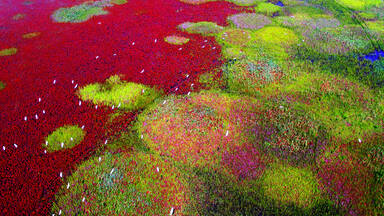World Wetlands Day 2022: Wetlands Action for People and Nature
Today is World Wetlands Day with the theme: Wetlands Action for People and Nature, highlighting the importance of action which ensures that wetlands are conserved and sustainably used.
The World Heritage Convention works continuously with multiple entities with this aim of protecting the most important wetland systems in the world sustainably for future generations. Wetlands are currently protected under different designations, including the UNESCO Man and Biosphere Programme and the Ramsar Convention on wetlands. Currently almost 100 UNESCO World Heritage wetlands are overlapping wholly or partially with over 140 Ramsar Sites.
A joint World Heritage and Ramsar report Ramsar and World Heritage: lasting cooperation to foster conservation - UNESCO World Heritage Centre illustrates the significance of this year’s ‘People and Nature’ theme through its focus on cooperation for optimal protection of nature and culture. In addition, the UNESCO and Ramsar workshop titled, “The Cultural and Spiritual Significance of Wetlands – Supporting the integration of nature and culture in their governance and management” at the International Academy for Nature Conservation of the Federal Agency for Nature Conservation further emphasizes the crucial role of the World Heritage wetlands as instruments to mobilize action for people and nature conservation.
Learn more about our synergies with the Ramsar Convention here: World Heritage Centre - World Heritage and Ramsar Convention on Wetlands (unesco.org)
Through inscription, UNESCO World Heritage sites benefit from synergies such as Ramsar and networks working together for conservation. During the last 44th extended session of the World Heritage Committee, Getbol Korean Tidal Flats (Republic of Korea) was inscribed on the World Heritage List for its demonstration of the dependence of cultural diversity and human activity on the natural environment. The site conveys the benefits of wetlands for both people and nature as the area is also well-known for its unique cultural tradition to produce salt from the tidal flats. The Getbol site is also overlapping with 4 Ramsar Sites, and growing World Heritage wetlands in the Yellow Sea.
Budj Bim Cultural Landscape (Australia) is another important wetland site in the Pacific and is one of the world’s most extensive and oldest aquaculture systems managed by the Gunditjmara people, along with Saloum Delta in Senegal. Both Budj Bim Cultural Landscapes and Saloum Delta are cultural sites - did you know that nearly one third of dual Ramsar and World Heritage wetlands are inscribed for their cultural values on the UNESCO World Heritage List?
Wetlands on the UNESCO World Heritage List are also fundamental to achieving many of the 2030 Sustainable Development Goals (SDGs), including those focused on water and sanitation, ecosystems, poverty reduction, food security, climate change, sustainable cities, gender equality and peace, among others. For example, the protection and restoration of wetlands is necessary to delivering water for all (SDG 6). Currently, more than 2 billion people live in countries with excess water stress, and water demand globally is projected to increase by 55% between 2000 and 2050.
While the World Heritage Convention’s one-of-a-kind international mandate facilitates the protection of UNESCO World Heritage wetlands belonging to all of humanity, we are facing a growing freshwater crisis that threatens people and nature. We are using more freshwater than nature can replace, and are destroying the ecosystem that water and life depend on. Water and wetlands are connected in an inseparable co-existence that is vital to life, our well being and the health of our planet.
UNESCO World Heritage wetlands are the most outstanding on earth but despite their iconic status, the irreplaceable crucial functions of wetlands require us to continue protecting them for current and future generations to come. Learn more about our work to protect UNESCO World Heritage wetlands in the World Heritage Review issue on Wetlands.


